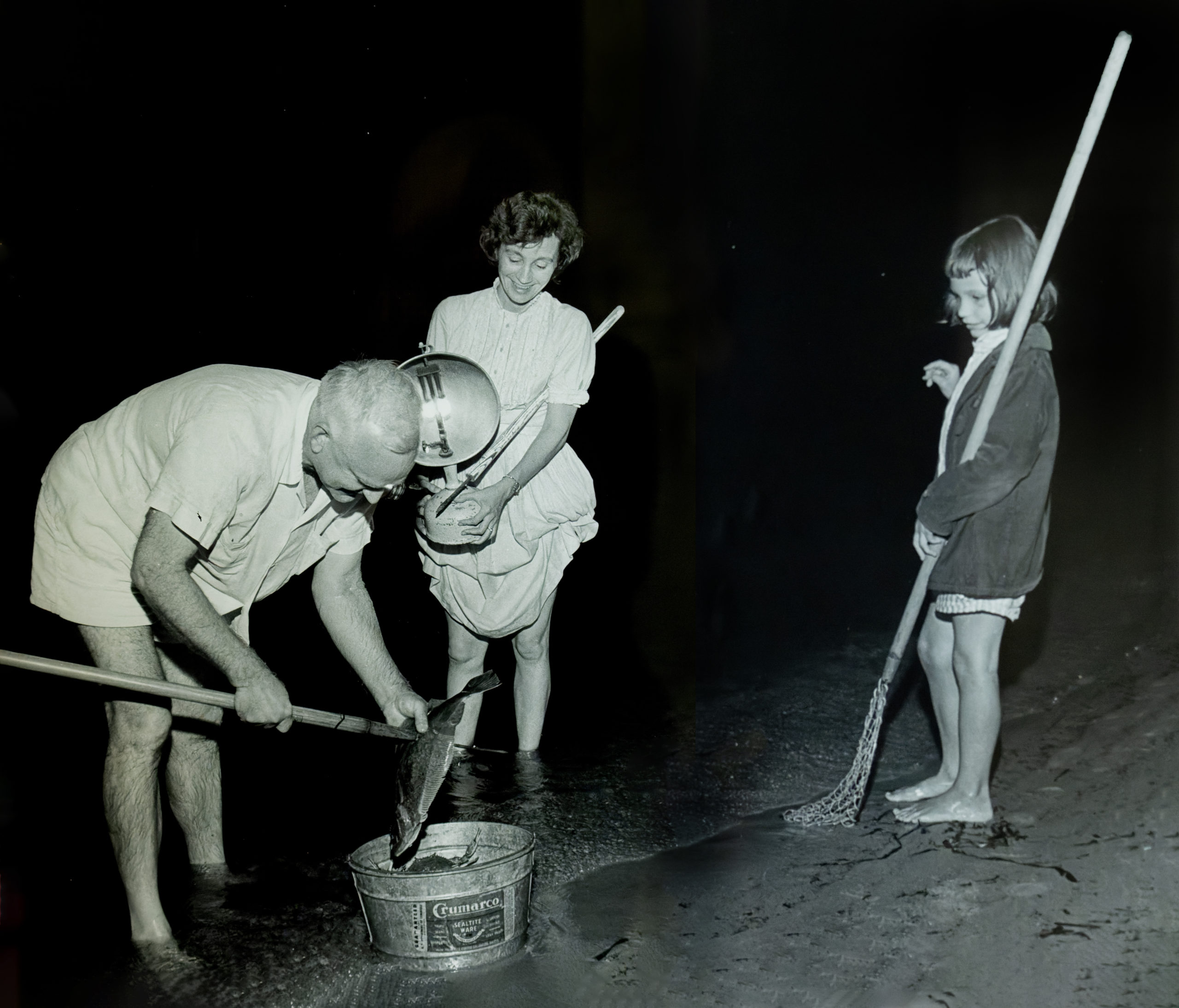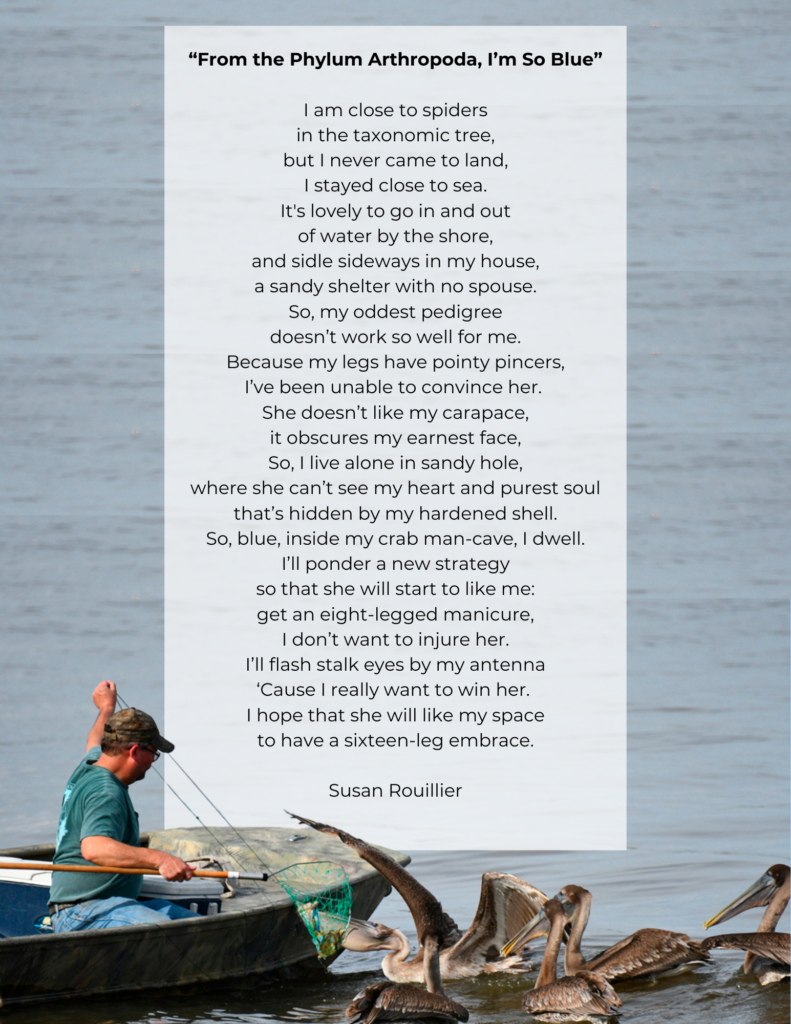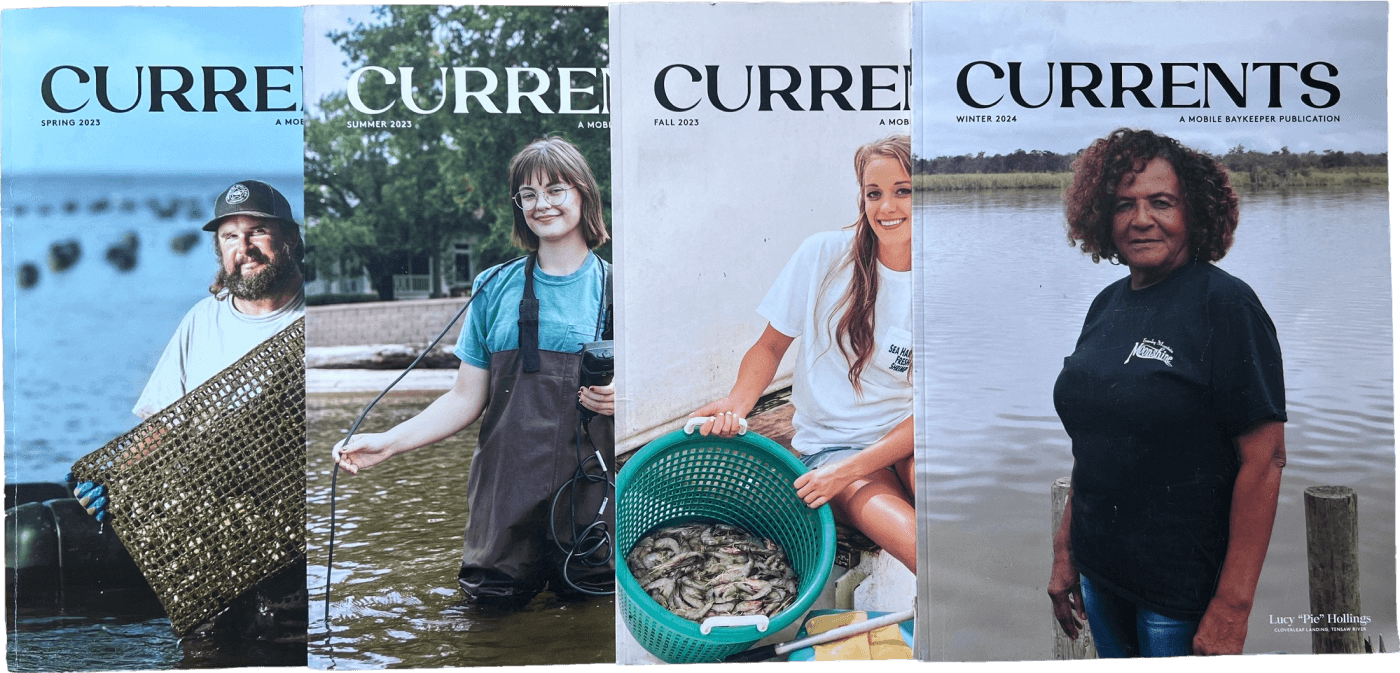
This article is from the fall 2024 edition of Mobile Baykeeper’s print quarterly, CURRENTS. The magazine is mailed to active members who have given more than $50 in the past year. To get on the magazine’s mailing list, donate here.
by Susan Rouillier | Flounder gigging and crabbing with a butane light on Mobile Bay around 1970. Photo courtesy Michelle Garner-Janna
There is nothing quite like the taste of our fresh, steamed blue crabs on a warm evening by Mobile Bay. The Gulf breeze, the sound of the water, and the rich, buttery flavor of the crabs create an unforgettable experience.
How to catch Blue Crabs on Mobile Bay’s Shores
In the summer, under a full moon with calm waters, you could see the lights moving slowly along the sandy shores of Mobile Bay. The lights belonged to softshell crabbers. They had only a few tools: a butane torch with a burning mantle, a small washtub, and a large-holed net on a pole. The scene was romantic and beautiful, only occasionally interrupted by a mosquito or a no-see-em bite.
The method was simple: walk slowly in knee-deep water through the grass beds, and shine the light through the shallow water, especially around pier-pilings or small depressions on the Bay floor. Hard-shelled crabs scurried away unless the light hit them directly in the face, and then you had to be quick with the net. These crabs were scooped up and placed in the tub with some seaweed to keep them from literally tearing each other apart. Softshell crabs, vulnerable after shedding their shells, could be picked up with your hands and placed in a separate pouch to prevent them from being eaten by the others.
My father told the story of gathering crabs from Cedar Crescent to Terrell Road one night, placing them in a croaker sack and dragging it behind him. When he returned home, the crabs had pierced through the cloth sack, escaped and only a couple of crabs were left from the long night’s work.
Soft-shell crabs, eaten legs and all, were best dusted in flour and sautéed in butter. It was delicious food, free for the taking. But the lights haven’t been seen along the shores for 15 years. The grass beds are gone, the water is no longer clear, and the shore’s bottom is thick and muddy from dredging and wave actions of massive ships carrying cargo into the port.
People still catch crabs today using crab cages, circular wire stringed baskets, or “chicken on a string,” also known as “depression crabbing,” which meant tying chicken bones to a string, throwing it out, waiting for a crab to bite, then slowly pulling it in to net it.
Enjoying the Harvest
Blue crabmeat, crabs, and soft-shell crabs are available in Mobile’s local seafood shops. Alabama crab fishermen land between 1 and 2.5 million pounds of crab out of the Gulf of Mexico and Mississippi Sound each year. An estimated 5 million pounds of live blue crabs are processed annually in Alabama, with trucks arriving each night from neighboring states like Louisiana, Florida and Mississippi.
Two of the most popular recipes for blue crabs in Mobile are crab cakes and West Indies Salad, the latter of which was first created in 1947 by the restaurateur William “Bill” Bayley, Sr., the owner of Bayley’s Steak House on Dauphin Island Parkway. (On the last page of this issue, you can find a crab cake recipe shared by Hollie A. LeJeune, the previous owner of Market by the Bay restaurant in Daphne.)
For this article, we spoke with Randi Cannon, a PhD candidate in Marine Ecology at Dauphin Island Sea Lab, about our blue crabs.
What has research shown about the health of the population of blue crabs in Mobile Bay?
I can say as a personal anecdote, that when in the field or handling oysters off the Dauphin Island Sea Lab dock, blue crabs are abundant. We often see juveniles on the oyster reefs we sample or hanging around the oyster cages at local farms. Sometimes they even make their way inside the cage and are presented with a wonderful buffet of oysters.
What is the life cycle of a blue crab?
Blue crabs begin their lives as tiny larvae, called zoea, often hatched offshore in higher salinity waters. As they molt and grow larger, into what we call megalopae, they begin to move closer to shore where food is more abundant. When they’re young they molt quite often, which is how they grow; they shed their hard outer shell (“exoskeleton”) and emerge as a soft-bodied version of themselves, and by absorbing water they grow and eventually harden yet again. They molt into the traditional shape of a blue crab (at about 2mm) and make their home in estuaries as juveniles. When it’s time to mate, the female crabs will move farther inshore to mate with the male blue crabs before they once again move offshore with their eggs. The eggs, once fertilized, will take one to two weeks to hatch, and the cycle starts all over again.
What is the distribution and density of the crabs in our waters, both in the rivers and in Mobile Bay? Are they more concentrated in certain areas?
This can fluctuate due to the season, gender, and age of the crabs. For the most part, we see juveniles and adult males in the lower salinity waters of the rivers and Bay. Meanwhile, adult females will often be in the higher salinity waters of the lower Bay, or offshore completely. We see a concentration of crabs in estuarine zones with substrate that they can hide or hunt around, like an oyster reef. The appearance of blue crabs is highest in the spring and summer, and depending on how severe the winter months are, they will often bury themselves to avoid colder temperatures and we see them less often.
Is it healthier to collect blue crabs from Gulf waters, river waters or Bay waters?
There’s not much difference, and I think this is mostly location-based. For example, you wouldn’t want to eat seafood in an area that is prone to sewage outflow. I think your safest and easiest bet for catching edible crabs would be in the Bay, as the juveniles will be what is mostly caught in the extremely freshwater riverine systems. Gulf blue crabs are also fine.
Are they safe to eat today?
Yes, they are! The main thing to avoid is eating a crab that’s been sitting dead in the crab trap. If it’s dead, throw it out or you can use it to re-bait the trap. Additionally, when eating local seafood, be aware of the water quality conditions, so you avoid ingesting something dangerous or toxic.
What are the restrictions on size or numbers for crabbing?
In Alabama there are restrictions for the number of crab traps an individual can use (5 per person) and you must have a Saltwater Fishing License with the state of Alabama. Crabs must measure 5 inches point to point. There are also regulations about where traps can go, mainly to ensure that they do not block boat traffic. From January to May, egg-bearing females must be thrown back immediately.
Any super interesting facts about blue crabs?
When in holding tanks in the lab, they appear to make vocalizations or clicking noises to perhaps tell us they are not happy with us? Also, they pee from their eye stalks! Their excretory glands can be found up by their antenna and behind their eyes and they will often squirt out their urine during a fight!

